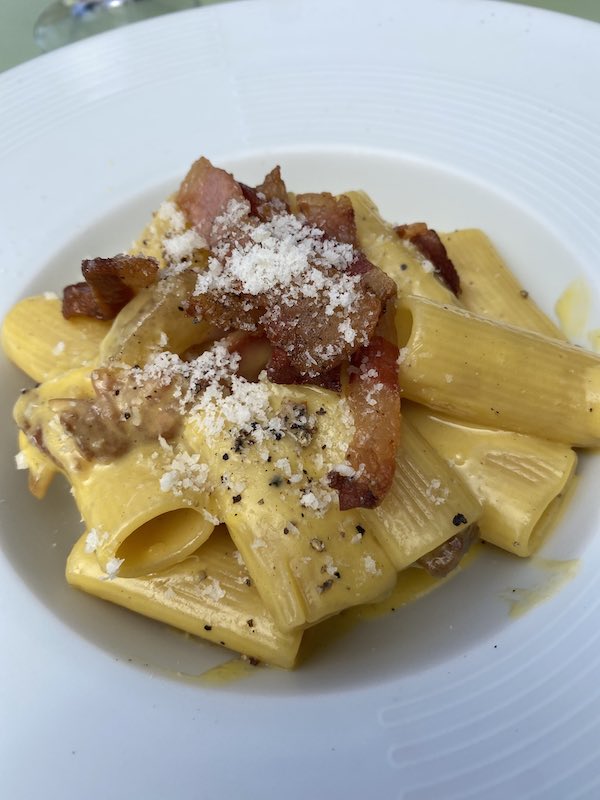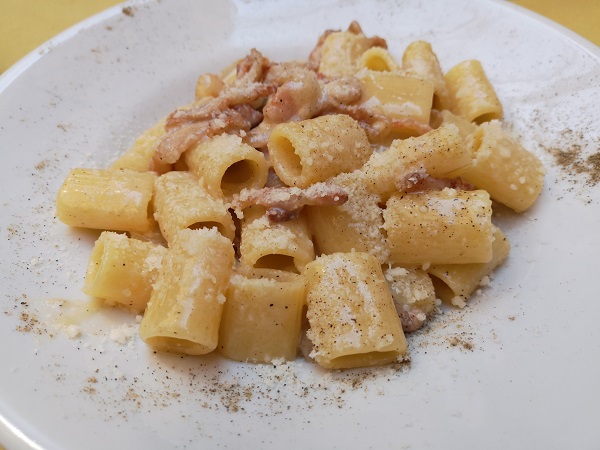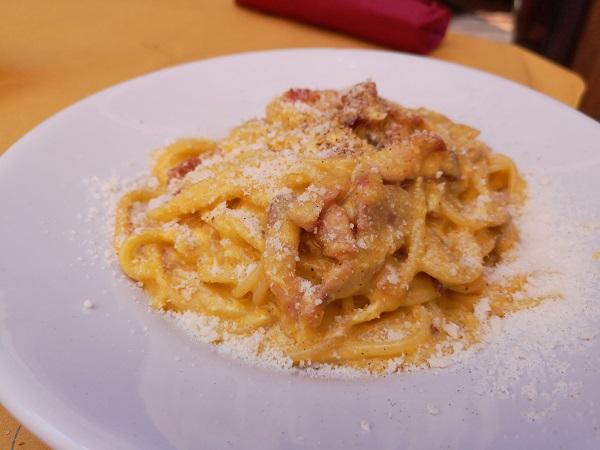Rome pasta dishes to try while in Rome, best Rome restaurants for each and easy to follow recipes to replicate them at home
Rome cuisine is famous for many specialties ranging from appetizers to meat.
However, it is pasta the real star of the Rome culinary show and especially four pasta dishes are so famous and so linked with the history of the city, they are basically a local identity!
Rome pasta dishes developed from the simple ingredients and culinary uses of the people living in the countryside around the city, a land of shepherds, farmers and cheesemongers living off their animals and their products.
As you will see from the recipes below, this means that Rome recipes tend to rotate around the same handful of ingredients, with results that are at the same time similar to one another yes diverse enough to offer variety and suit different tastes.
Rome is the home of tasty, warming and world famous pasta dishes and fabulous restaurant where to try them.
In this article, I will share the most famous Rome pasta dishes to seek out in Rome, the best restaurants where to taste each and east to follow recipes to bring real Rome pasta flavors to your dinner table, no matter where you are.
Rome pasta dishes chart
The most popular pasta dishes in Rome are carbonara, cacio e pepe, amatriciana, and gricia.
A dish foreigners tend to know less but that is very popular and traditional Rome pasta dish is also pasta with romanesco, very much a Rome staple!
Pasta con Romanesco is harder to find in restaurants yet it is common in Rome households and I highly recommend you try it if you have the chance!
| Name of Pasta Dish | Main ingredients for the sauce | Vegetarian/Vegan |
| Carbonara | Eggs, cheese, pork | No |
| Cacio e pepe | Cheese, black pepper | Vegetarian (uses cheese) |
| Amatriciana | Tomatoes, pork, cheese | No |
| Gricia | Cheese, pork | No |
| Pasta con Romanesco | Romanesco broccoli, sausage | No (but can be adapted to be a veggie dish) |
The main ingredients of Rome pasta dishes
As you can see from the table above, the ingredients of all typical pasta dishes from Rome tend to repeat themselves and include mainly two items: pecorino romano (aka: cacio) and guanciale, combined in several ways for a variety of results.
Pecornino Romano or Cacio – pecorino romano or cacio is a type of cheese from Lazio, the region of Rome.
The name pecorino gives away the fact that this is a sheep cheese (pecora= sheep) and this is a salty, crumbly cheese with a history so long, it seems to date back to ancient Roman times.
Pecorino is commonly used especially as a grating cheese and it is in origin a poor ingredient with roots in the kitchens of the shepherds of Lazio now loved by foodies worldwide.
If you cannot get hold of pecorino, you can sometimes replace it with parmesan instead.
However, both the taste and the consistency of the sauce will be affected, especially in cacio e pepe (see below), so this substitution is only recommended if you have no other choice
Guanciale – Guanciale is meat, specifically the cheek/ jaw of the pig.
It is a cut of meat particularly dear to Rome cuisine and it is usually cured with salt, pepper and herbs, that make it rather tastier than the other cut it is usually compared to: pancetta.
While similar in some respects, pancetta comes from the belly of the pig rather than the cheek and it is cured rather differently.
Guanciale is not often easy to find abroad and, in that case, sweet pancetta is often a decent substitution: I find bacon, on the other hand, does not work.
5 Rome pasta dishes with recipes to try in Rome and back home
These are the most traditional pasta dishes you can taste in Rome and the recipes you need to make them at home, wherever you are!
Carbonara
Pasta alla carbonara (carbonara pasta) is maybe the most famous Rome pasta dish of all.
Replicated worldwide yet very often misunderstood and mis-prepared, carbonara is a flavorsome pasta dish that mixes eggs with two quintessential roman ingredients: guanciale and Pecorino Romano, bound by creamy eggs. The key to preparing real carbonara is both in the ingredients and the execution, which relies on the ability to create a smooth creamy sauce rigorously without the addition of cream.
When making carbonara, the egg sauce doesn’t cook on the side – rather, the raw egg mixture gets added to the pasta once ready and relies on the heat of the pasta for cooking on the spot.

If done correctly, the hot pasta pasteurizes the eggs without cooking them fully and turning them into scrambles eggs, the most common mistake when making carbonara.
Some of the best places to eat carbonara in Rome city center are: Mimi e Coco’, Da Gino al Parlamento, Al Grappolo d’Oro.
You can find my full, easy to follow real carbonara recipe with also acceptable and non-acceptable ingredient substitutions for replicating the best result at home here >>> REAL Carbonara recipe from Rome (no cream, step by step recipe)
Cacio e Pepe
Cacio e pepe is an apparently simple yet very flavorsome pasta dish from Rome.
The name cacio e pepe comes from the two ingredients at the basis of this pasta dish: cacio (a special type of cheese, pecorino romano) and pepe, black pepper.
Despite the simplicity of the ingredients, cacio e pepe often is reason for culinary disasters, usually due to the use of the wrong type of cheese. In this case, getting the right cacio truly is key.

Pecorino romano for cacio e pepe matures in such as way that when mixed with hot pasta develops into a smooth cream – this sets it apart from other cheeses that instead tends to great big lumps, ruining the result
The best cacio e pepe in Rome is said to be served Felice a Testaccio which is a city institution.
You can find my exact recipe with step by step guide to get a smooth result here >>> Cacio e pepe recipe and tips
Amatriciana
Amatriciana is another famous Rome pasta dish and the only one in this list with tomato sauce.
Amatriciana comes from the town of Amatrice, near Rome, and has the ingredients we have already seen in the pasta dished above, cacio and guanciale, in this case prepared with sauce made with fresh tomatoes.
Amatriciana is offered all over the word but a little like carbonara, it is often misunderstood or complicated with no reason.
Amatriciana only uses few ingredients and does not need onion nor garlic, the taste coming from the quality and rich saltiness of the genuine ingredients.

Amatriciana is usually served with bucatini pasta or anyway long pasta shapes and some of the best places for Amatriciana in Rome city center are Armando al Pantheon (City center) and La Ciambella Bar a vin (this is one of my favorite addresses of all).
You can find here >>> my easy to follow amatriciana recipe
Pasta alla gricia
Pasta alla gricia is made of by ingredients you are by now familiar with: pecorino romano and guanciale!
It is often referred to as egg free carbonara or a tomato free Amatriciana and indeed the preparation is very similar to both, minus the bonding sauce and also its geographical provenance seems to be close to that of Amatriciana.

Gricia seems to come from ‘Grisciano’, a locality near Amatrice, not far from Rome. This is a wonderful flavorsome and filling dish and, like cacio e pepe, one where the quality of ingredients and the skill in the execution is king.
Some of best places to taste pasta alla gricia in Rome are Enzo al 29 (Trastevere) and Armando al Pantheon (city center)
You can find here >>> my simple yet delicious pasta alla gricia recipe
Pasta with Romanesco
Pasta with Romanesco is a very popular Rome pasta dish that uses one of the most typical vegetables from the Rome region: romanesco (also called romanesco broccoli or romanesco cauliflower).

The most traditional way to make this pasta is mixing romanesco with Italian sausage, which results in a super tasty and complete meal.
However, you can also make this pasta with anchovies instead or make it fully vegetarian eliminating the meat altpogther and using roasted pine nuts instead.
A nice twist on a classic!
You can find here >>> my easy to follow recipe to make pasta with Romanesco
What pasta shapes for Rome pasta dishes
Rome pasta dishes usually are served with a specific pasta format however, the rules are not necessarily very strict
Spaghetti are a good choice for all the dishes on this list
Rigatoni are a good choice with Amatriciana and Gricia
Bucatini are perfect for all these dishes and the most local of all pasta shapes for the Rome area, being especially popular in Lazio
Short shape pasta is usually not ideal with carbonara although some chefs are able to now make it work. This is however not something I recommend at home as the risk of messing up your dish is high – if in doubt, spaghetti is good!
What to serve with these pasta dishes from Rome
The traditional Italian meal structure foresees a starter, a pasta dish, a meat or fish course, and side dish, usually sauteed vegetables.
You don’t need to create a full banquet to accompany your Rome pasta endeavor however, if you want to keep the theme going, there are some ideas:
Roman Appertizer – such as Rome style artichokes or deep fried artichokes ‘jewish style’ (Carciofi alla Giudia)
Meat course – saltimbocca alla romana (veal saltibocca)
Side – sauteed chicory
I hope you enjoyed this overview of the most famous pasta dishes that are traditional in Rome and it inspired you to try them in Rome and at home. Buon appetito!

